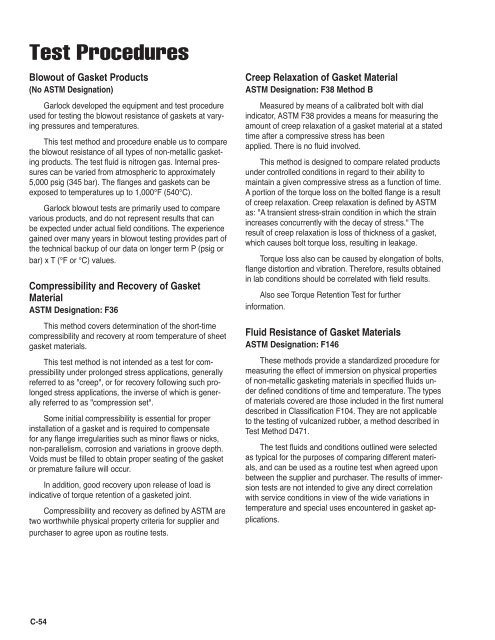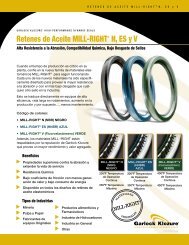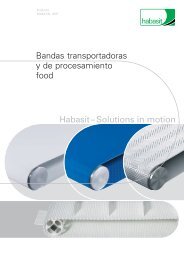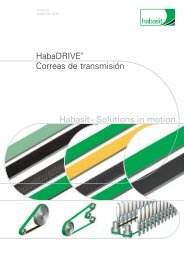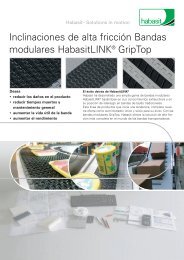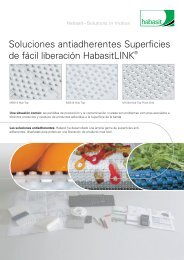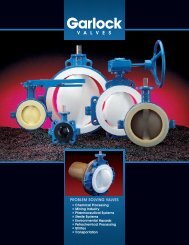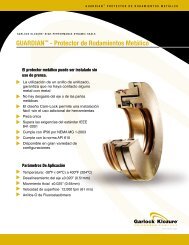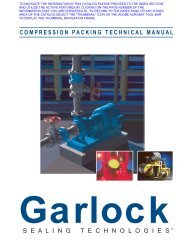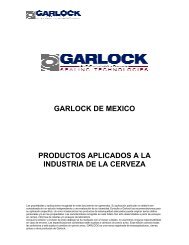Engineered Gasketing Products
Engineered Gasketing Products
Engineered Gasketing Products
- No tags were found...
You also want an ePaper? Increase the reach of your titles
YUMPU automatically turns print PDFs into web optimized ePapers that Google loves.
Test ProceduresBlowout of Gasket <strong>Products</strong>(No ASTM Designation)Garlock developed the equipment and test procedureused for testing the blowout resistance of gaskets at varyingpressures and temperatures.This test method and procedure enable us to comparethe blowout resistance of all types of non-metallic gasketingproducts. The test fluid is nitrogen gas. Internal pressurescan be varied from atmospheric to approximately5,000 psig (345 bar). The flanges and gaskets can beexposed to temperatures up to 1,000°F (540°C).Garlock blowout tests are primarily used to comparevarious products, and do not represent results that canbe expected under actual field conditions. The experiencegained over many years in blowout testing provides part ofthe technical backup of our data on longer term P (psig orbar) x T (°F or °C) values.Compressibility and Recovery of GasketMaterialASTM Designation: F36This method covers determination of the short-timecompressibility and recovery at room temperature of sheetgasket materials.This test method is not intended as a test for compressibilityunder prolonged stress applications, generallyreferred to as "creep", or for recovery following such prolongedstress applications, the inverse of which is generallyreferred to as "compression set".Some initial compressibility is essential for properinstallation of a gasket and is required to compensatefor any flange irregularities such as minor flaws or nicks,non-parallelism, corrosion and variations in groove depth.Voids must be filled to obtain proper seating of the gasketor premature failure will occur.In addition, good recovery upon release of load isindicative of torque retention of a gasketed joint.Compressibility and recovery as defined by ASTM aretwo worthwhile physical property criteria for supplier andpurchaser to agree upon as routine tests.Creep Relaxation of Gasket MaterialASTM Designation: F38 Method BMeasured by means of a calibrated bolt with dialindicator, ASTM F38 provides a means for measuring theamount of creep relaxation of a gasket material at a statedtime after a compressive stress has beenapplied. There is no fluid involved.This method is designed to compare related productsunder controlled conditions in regard to their ability tomaintain a given compressive stress as a function of time.A portion of the torque loss on the bolted flange is a resultof creep relaxation. Creep relaxation is defined by ASTMas: "A transient stress-strain condition in which the strainincreases concurrently with the decay of stress." Theresult of creep relaxation is loss of thickness of a gasket,which causes bolt torque loss, resulting in leakage.Torque loss also can be caused by elongation of bolts,flange distortion and vibration. Therefore, results obtainedin lab conditions should be correlated with field results.Also see Torque Retention Test for furtherinformation.Fluid Resistance of Gasket MaterialsASTM Designation: F146These methods provide a standardized procedure formeasuring the effect of immersion on physical propertiesof non-metallic gasketing materials in specified fluids underdefined conditions of time and temperature. The typesof materials covered are those included in the first numeraldescribed in Classification F104. They are not applicableto the testing of vulcanized rubber, a method described inTest Method D471.The test fluids and conditions outlined were selectedas typical for the purposes of comparing different materials,and can be used as a routine test when agreed uponbetween the supplier and purchaser. The results of immersiontests are not intended to give any direct correlationwith service conditions in view of the wide variations intemperature and special uses encountered in gasket applications.C-54


